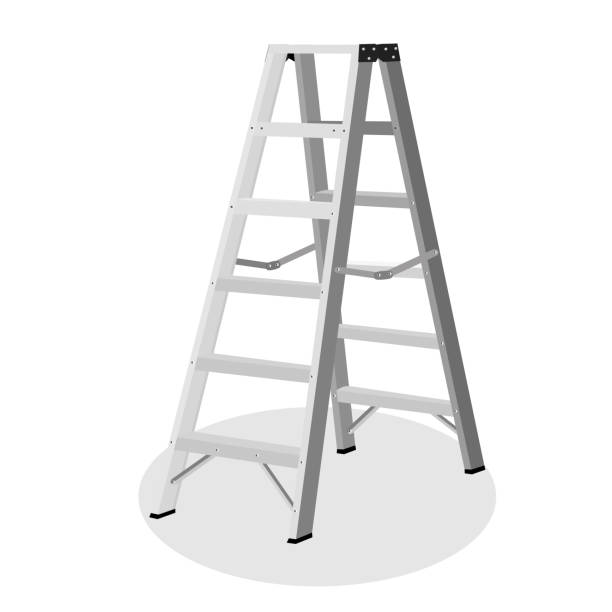Introduction
Ensuring safety while ascending step ladders is paramount. This article delves into the intricacies of ladder safety, shedding light on various aspects that contribute to a secure climbing experience.

1. Choosing the Right Step Ladder
Selecting an appropriate ladder for your task is the first step in ensuring safety. Explore different types and their specific use cases.
2. Inspecting for Stability
Before ascending, perform a thorough check for any signs of instability. Wobbles and uneven footing can be early indicators of potential hazards.
3. Weight Capacity Matters
Understanding the weight capacity of the ladder is crucial. Exceeding this limit can compromise stability, posing a risk to your safety.
4. Proper Placement on Solid Ground
Placing the ladder on a stable and level surface is fundamental. Avoid soft or uneven ground that may lead to accidents.
5. Maintaining Three Points of Contact
Always ensure three points of contact while climbing: two hands and one foot, or two feet and one hand. This enhances stability and reduces the risk of falls.
6. Securing the Top
If using an extension ladder, secure the top to prevent accidental slipping. This adds an extra layer of safety during your ascent.
7. Weather Awareness
Avoid ladder use in adverse weather conditions. Rain, strong winds, or icy surfaces can significantly increase the risk of accidents.
8. Wearing Appropriate Footwear
Choose non-slip footwear to enhance grip and reduce the chances of slipping on the ladder steps.
9. Regular Maintenance Checks
Periodic inspections and maintenance ensure that your ladder is in optimal condition, reducing the likelihood of unexpected malfunctions.
10. Understanding Load Limits
Apart from personal weight, factor in the weight of tools and materials you carry. Adhering to load limits is crucial for safety.
11. Storing Ladders Properly
Store ladders in a dry and cool place to prevent damage and degradation over time. Proper storage extends the lifespan of your equipment.
12. Ladder Angles for Stability
Maintain a 75-degree angle when leaning the ladder against a surface. This provides optimal stability during use.
13. Using Ladder Accessories
Explore and use ladder accessories such as stabilizers and levelers to enhance safety during various tasks.
14. Emergency Response Preparedness
Familiarize yourself with basic first aid and emergency procedures. Being prepared adds an extra layer of safety confidence.
15. Avoiding Overreaching
Overreaching is a common cause of ladder accidents. Always reposition the ladder to avoid stretching beyond your reach.
16. Considering Age and Health Factors
Individual health and age can influence ladder safety. Be mindful of your physical condition and capabilities before climbing.
17. Proper Descending Techniques
Descending the ladder properly is as important as ascending. Follow recommended techniques to avoid accidents during descent.
18. Ensuring Proper Lighting
Good visibility is key to ladder safety. Adequate lighting in the work area prevents missteps and enhances overall safety.
19. Educating Others
Spread awareness about ladder safety among colleagues and family members. Knowledge-sharing contributes to a safer environment.
20. Safe Use of Step Stools
When using step stools, apply the same safety principles as with larger ladders. Stability and proper use are equally essential.
21. Common Mistakes to Avoid
Highlight common errors that users make, helping readers learn from others’ experiences and avoid potential pitfalls.
22. Expert Tips for Enhanced Safety
Incorporate expert advice and tips from seasoned professionals to elevate your ladder safety practices.
23. Real-life Stories of Safety Success
Share inspiring stories of individuals who prioritized ladder safety and reaped the benefits of accident-free practices.
24. FAQs about Ladder Safety
Answering common questions to provide comprehensive information and address reader queries effectively.
Are Step Ladders Safe? Common Questions Answered
Q: How do I choose the right step ladder for my task?
A: Consider the height needed, type of work, and weight capacity. Refer to the ladder’s safety guidelines for proper selection.
Q: Can I use a ladder in rainy conditions?
A: It is not recommended. Wet surfaces can be slippery, increasing the risk of accidents. Wait for dry conditions before ladder use.
Q: Are there weight limits for using step ladders?
A: Yes, every ladder has a weight capacity. Exceeding this limit can compromise stability and pose a safety risk.
Q: What should I do if my ladder feels unstable during use?
A: Descend immediately and inspect the ladder for any visible issues. Do not continue using an unstable ladder.
Q: How often should I inspect my ladder for maintenance?
A: Regularly inspect your ladder before each use. Additionally, perform a detailed check at least once a month.
Q: Are step stools as safe as larger ladders?
A: Yes, if used correctly. Follow safety guidelines for step stools, and they can be as safe as larger ladders for specific tasks.
Conclusion
By implementing these safety measures, you can confidently answer the question, “Are step ladders safe?” With proper awareness, equipment usage, and caution, step ladders can be a secure tool for various tasks.
